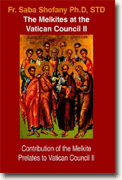The Melkites at the Vatican Council II
Saba Shofany
book reviews:
· general fiction
· chick lit/romance
· sci-fi/fantasy
· graphic novels
· nonfiction
· audio books
· author interviews
· children's books @
curledupkids.com
· DVD reviews @
curledupdvd.com
newsletter
win books
buy online
links
home
for authors
& publishers
for reviewers

 |
The Melkites at the Vatican Council II: Contribution of the Melkite Prelates to Vatican Council II Saba Shofany Authorhouse Hardcover 348 pages September 2005 |
|
Who are the Melkites, and what were they doing at the Second Vatican Council? Wasn’t that a Roman Catholic Council?
Fr. Shofany begins his book with a summary of the history of the Greek Melkite Church. “Melkite” is Syriac for “Partisan of the Emperor” or “King’s man,” the Emperor referred to being the Byzantine Emperor. The Melkites followed the teachings of the Council of Chalcedon dealing with the dogma of the two natures of Christ, human and divine. The leader of the Melkites, a minority in the Syrian part of the Byzantine Empire, was the Patriarch of Antioch. When the Muslims invaded, many Melkites fled to Rome and Constantinople. Some of the popes of the seventh and eighth centuries were of Syrian or Melkite origin - Popes Theodore (d. 649), John V (d. 686), Sergius (d. 701), Sissinius (d. 708), Constantine (d. 715), and Gregory III (d. 741). Some were actually born in the Middle East, while others were of Syrian heritage. As time progressed, the Melkites in Syria and other parts of the Middle East came more and more under the control of the Patriarch of Constantinople to the point that the Patriarch of Antioch became subservient to him. In 1054, when the Pope and the Patriarch of Constantinople excommunicated each other, the Melkites remained loyal for a while to Rome. Eventually, though, the Melkite leadership gave in to the Patriarch of Constantinople. The Crusades did not help matters, either. In the seventeenth century, the Patriarch of Antioch and other Melkites began moving toward a union with Rome, eventually accomplished with Patriarch Cyril VI in 1724. Those Melkites who opposed the union had their own Patriarch, causing the Greek Melkite Church to split. Fr. Shofany’s summarizes their history and provides footnotes in various languages; a Melkite Information Center is available online at www.Melkite.org. Many of the Melkite prelates had attended universities in Rome or other Western countries. They had strong backgrounds in both Eastern and Western theologies and were well-prepared to speak out for the Eastern Church and to remind the Western Church that the Catholic Church, as Pope John Paul II said, had two lungs. They did so by insisting upon the rank of the Eastern Patriarchs which, by tradition, came immediately after the Pope and before the Cardinals. For some time the patriarchs had been ranked after the cardinals, but at the Council they were successful in regaining their proper rank. The Melkites hoped to serve as a bridge between the Catholic and Orthodox Churches. Very involved in the discussions of Council documents throughout the various sessions, they did not just sit and listen. Many Melkite prelates addressed the Council on issues they thought important enough for them to speak up or intervene: issues of ecumenism, especially with the Orthodox Church; moral issues; the sacraments; and other topics, always emphasizing the Eastern Church’s point of view or tradition. The prelates not only relied upon their own theologians but also received help from Western theologians, ultimately succeeding in keeping the Church balanced between East and West. Fr. Saba Shofany was ordained a Greek Melkite priest in 1995 in Israel. In 2002 he was assigned to the parish of St. Michael the Archangel Melkite Catholic Church in Hammond, Indiana. He has a BA in philosophy and theology from the Angelicum Pontifical University, MA in bio-ethics from the Lateran Pontifical University, and STD in moral theology from the Lateran. Fr. Shofany includes a preface from Archbishop Cyril S. Bustros, Eparch of Newton, short biographies of the prelates who attended Vatican II, copies of some of the interventions delivered at the Council, a bibliography, and footnotes. There are many non-English sources given, which is appropriate. Fr. Shofany’s research is extensive and provides Greek Melkite Catholics and Roman Catholics an Eastern point of view on the Second Vatican Council. The reader will discover that the author’s first language is not English, but this is a minor problem - the text is still very readable. This book is highly recommended to those studying the Second Vatican Council who want an Eastern view. Originally published on Curled Up With A Good Book at www.curledup.com. © Br. Benet Exton, O.S.B., 2006 |
|
|
|
 Click here to learn more about this month's sponsor! |
|
| fiction · sf/f · comic books · nonfiction · audio newsletter · free book contest · buy books online review index · links · · authors & publishers reviewers |
|
| site by ELBO Computing Resources, Inc. | |
 The Greek Melkite Church is currently (but was not always historically) one of the Eastern Churches in union with Rome; some Melkites are still not in communion with the Pope. Fr. Saba Shofany, a Melkite priest, offers his research into the contributions of the Melkite Church to the Second Vatican Council. In 2005 the 40th anniversary of the conclusion of this monumental Council was celebrated, and this book is an appropriate addition to its commemoration.
The Greek Melkite Church is currently (but was not always historically) one of the Eastern Churches in union with Rome; some Melkites are still not in communion with the Pope. Fr. Saba Shofany, a Melkite priest, offers his research into the contributions of the Melkite Church to the Second Vatican Council. In 2005 the 40th anniversary of the conclusion of this monumental Council was celebrated, and this book is an appropriate addition to its commemoration.